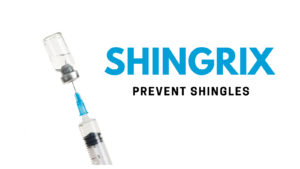New Shingrix Vaccine Prevents Shingles


What is Shingles?
Shingles occurs when the chickenpox virus (varicella zoster) goes from being dormant to active. No one knows exactly why that happens, although stress is suspected to be a factor.
More than 99% of adults worldwide who are age 50 and older have been exposed to the varicella zoster virus which means that they are carrying the dormant virus. According to the CDC, shingles strikes about 1 million people in the U.S. each year and nearly one in three adults will experience a bout of shingles in their lifetime.
Up to 10% of those who get shingles experience long-term pain after the rash has healed. This condition is caused by nerve damage sustained during a shingles episode and is called postherpetic neuralgia. There is no cure for postherpetic neuralgia, but topical (lotions) and/or systemic (pills) medications can help ease the pain.
Symptoms of Shingles
Shingles affects individual nerves and the skin surfaces that are supplied by those nerves. A shingles episode starts with pain, tingling, numbness, and itching on one side of the body. Fever, headache, chills, and upset stomach may also occur. After one to five days, itchy fluid-filled blisters appear.
The rash can affect the eye when the virus is active in the ophthalmic nerve. A sign that the ophthalmic nerve is affected are blisters on the tip or side of the nose.
A shingles episode normally lasts 2-to-4 weeks. An antiviral taken early—72 hours after the first symptoms appear, can speed healing and reduce the risk of complications.
Why Do We Need a Shingles Vaccine?
The first shingles vaccine, Zostavax, was licensed in 2006 and recommended by the ACIP in 2008 for the prevention of shingles (herpes zoster) and its complications, but the vaccine was not extremely effective.
In clinical trials Zostavax recipients had a 51% overall reduction in developing shingles or of having a less severe episode when shingles did occur compared with the placebo recipients.
The breakdown was:
- 70% effective among persons 50-59 years of age
- 64% effective among persons 60-69 years of age
- 38% effective among persons 70 years and older
- Protection against shingles declined after vaccination and by six years after vaccination protection was less than 35%.
Shingrix Vaccine More Effective
The new vaccine—Shingrix, is given in two doses, two to six months apart, and according to the CDC, Shingrix offers 97 percent protection in people in their 50s and 60s, and about 91 percent protection for people in their 70s and 80s. The vaccine retained its high effectiveness throughout the four-year study.
What may account for the increased effectiveness is that the new vaccine contains an adjuvant (the second dose), which boosts the immune system’s response.
Insurance Coverage for Vaccine
Private insurers will probably cover the cost of Shingrix—which is $280 for the two shots. Most insurers covered the cost of the Zostavax vaccine (which was $213 for those who paid full price). Most Medicare Part D plans cover the cost of the new vaccine.
Check with your provider for details.
Shingles in the Eye
Shingles can affect the eye. Most often the cornea is involved causing pain, redness, tearing and decreased vision. Prompt treatment may avoid further complications. Occasionally, the virus can infect the internal structures of the eye including the retina.
Treatments vary depending upon severity and the structures of the eye involved.
We look forward to seeing you. If you would like to make an appointment or if you have questions, please call us.
Gregory Scimeca, M.D.
Ophthalmologist and Medical Director
Burlington County Eye Physicians
Eye Professionals, LLC (Millville, NJ)
Eye Physicians and Surgeons of Bucks County (Langhorne, PA)
